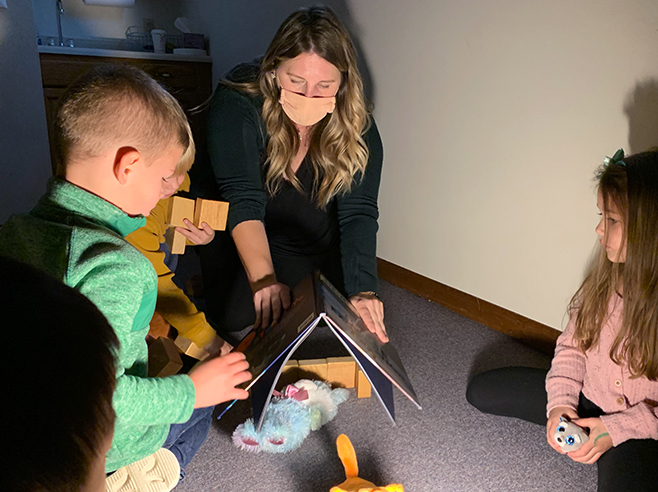Children create and test a structure that will block light and create shade for their toy pets to protect them from the hot sun.
Materials

- Light source, such as a bright LED lamp with an adjustable head
- Toy animal “pets”
- Materials for building structures, such as blocks, cardboard sheets, construction paper, cotton or linen cloth, felt pieces
- Scissors for cutting building materials
- Tape for attaching building materials
Preparation
- Gather the materials and set them up in the small group area. Shine the light on the toy pets.
- Make sure the desk lamp is accessible and can safely be moved around and repositioned.
- Note: Extend the activity time to two sessions if your young children need more time to grasp the shadow learning.
- Read through these Tips for Teaching Engineering to help support your young engineers as they become problem solvers:
- Acknowledge all ideas. Every idea is worth trying: That’s a great idea! Let’s try it!
- Allow children to fail or “get stuck.” This is when they get to figure out why their approach did not work and how they can revise it: Why do you think this structure didn’t work? What can you do to change it? Let’s test it!
- Encourage children to share and build on one another’s ideas. This helps them become communicators and collaborators in solving problems: I like how you used (child’s) idea and added your own idea to it!
Directions: Lesson 8
Guided Small Group
- EXPLORE. Encourage children to close their eyes and imagine playing outside on a hot, sunny day. Or, if possible, go outside and have children experience the sunny day. Have them describe what it feels like in the sun. Discussion ideas:
- Do you feel warm or hot or cold?
- How can you cool off if you get too hot?
- Now have them imagine they are sitting in the shade under a big tree. Have them describe what it feels like. Or go outside and sit in the shade, if possible. Discussion ideas:
- Does it feel the same as or different from being in the sun?
- How? Have you ever cooled off in the shade? Did you find the shade or make it yourself?
- Define the problem. Pretend the lamp is the sun. Shine the “sunlight” on the toy pets. Encourage children to describe how the pets might feel in the sun. What can you do to help them cool off? Tell children that they will design a shade structure to protect their pets from the hot “sun.”
- Draw attention to the materials. Have children explore the materials and plan their shade structure. Have them consider:
- What materials will block the light and create the best shade
- What materials will be strong enough to make a sturdy structure
- How the structure will keep from falling over
- Any other materials they might need
- CREATE. Brainstorm possible solutions. Encourage children to share their ideas on how they will:
- Build a structure that is large and strong enough and does not fall over
- Position the structure so it blocks the light and creates shade
- Have children build the shade structure. Encourage them to use ideas from the brainstorming session.
- IMPROVE. Test the solution. Once the structure is in place, review the problem and discuss whether the design solves the problem. Possible discussion ideas:
- Why are you building a structure to shade the (dogs)?
- What do you notice about your design? Is there enough shade?
- Does your structure solve the pets’ problem?
- Improve it. If something is not working, have children discuss and revise the design based on the test results. Possible discussion ideas:
- Why didn’t the design work? How can you change it?
- Are there other materials you need to make it work?
- How do you know the design is a good one?
- Children revise and test their solution to improve it. Encourage all children to participate as they test multiple solutions.
- SHARE. Document the engineering design process by taking pictures of the various iterations and the final solution with the Cool Shadows camera tool.
- Communicate. Look at a picture of the final design, ask:
- Is this design a good shade structure? Can you describe how it solves the problem?
- Look at a picture of an unsuccessful design. Why didn’t this design work? How did you improve it?
Learning Center
- Invite children, in pairs or individually, to continue exploring using various materials to create shade for their pets. Observe how children approach brainstorming, planning, building, testing, and revising their shade structure design. Use discussion ideas such as those used during earlier small group explorations to engage children in science and engineering discussions.
- Encourage children to restate the problem as they are planning their structures. Support children by allowing them to make and discuss mistakes, describe why a solution does/does not work, and build and test various iterations for solving the problem.
- Encourage children to listen to and build on each other’s ideas.


